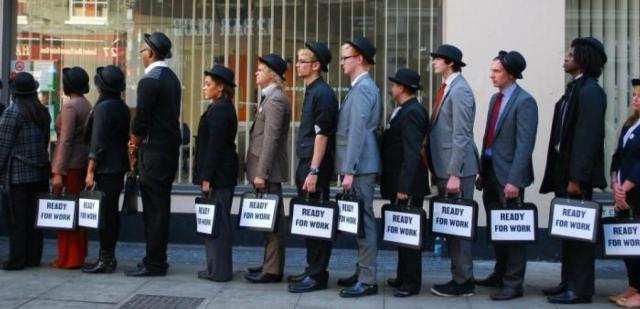CHICAGO – The Illinois Department of Employment Security (IDES) announced today that the unemployment rate declined 0.3 percentage points to 5.4 percent in February and nonfarm payrolls increased by +25,600 jobs over-the-month, based on preliminary data proved by the U.S. Bureau of Labor Statistics (BLS) and released by IDES. January job growth was revised up to show an increase of +8,100 jobs rather than the preliminary estimate of +1,700 jobs. February’s monthly payroll gain kept over-the-year job growth well below the national average, but Illinois now surpassed its prior peak employment reached in September 2000 by 100 jobs, even with some sectors such as manufacturing remaining 297,800 jobs below their prior peak.
Get The Latest News!
Don't miss our top stories and need-to-know news everyday in your inbox.
“After 17 years, Illinois jobs have finally regained their September 2000 peak,” said IDES Director Jeff Mays. “However, nearly 300,000 manufacturing jobs that existed in the year 2000 are no longer in Illinois. While many other states – including our neighbors – have had positive growth in manufacturing jobs in the last several years, Illinois has not.”
“Illinoisans deserve a state that attracts good paying jobs, especially because of the great assets we have here in Illinois,” said Illinois Department of Commerce & Economic Opportunity Director Sean McCarthy. “We cannot afford to waste another 17 years lagging behind. We need to make common sense reforms that will boost our economy and create more opportunities for Illinois families.”
In February, the three industry sectors with the largest gains in employment were: Government (+8,300); Construction (+7,300); and Education and Health Services (+5,800). The largest payroll declines were in the following sectors: Trade, Transportation and Utilities (-2,900); and Professional and Business Services (-500).
Over-the-year, nonfarm payroll employment increased by +47,000 jobs with the largest gains in these industry sectors in February: Education and Health Services (+15,300); Professional and Business Services (+12,100); and Government (+10,200). Industry sectors with the largest over-the-year declines include: Manufacturing (-7,400); and Other Services (-3,500). The +0.8 percent over-the-year gain in Illinois is half as strong as the +1.6 percent gain posted by the nation in February.
The state’s unemployment rate is higher than the national unemployment rate reported for February 2017, which decreased to 4.7 percent. The Illinois unemployment rate is down -0.7 percentage points from a year ago when it was 6.1 percent. At 5.4 percent, the Illinois jobless rate stands at its lowest level since October 2007.
The number of unemployed workers decreased -5.9 percent from the prior month to 352,400, down -12.5 percent over the same month for the prior year. The labor force increased +0.1 percent over-the-month but declined by -0.6 percent in February over the prior year. The unemployment rate identifies those individuals who are out of work and are seeking employment. An individual who exhausts or is ineligible for benefits is still reflected in the unemployment rate if they actively seek work.
To help connect jobseekers to employers who are hiring, IDES’ maintains the state’s largest job search engine IllinoisJoblink.com (IJL). IJL recently showed 51,115 resumes were posted and 179,073 help wanted ads were available.
Seasonally Adjusted Unemployment Rates

Illinois Seasonally Adjusted Nonfarm Jobs – by Major Industry

-
Monthly 2012 - 2016 labor force data for Illinois, and all other states, have been revised as required by the U.S. Bureau of Labor Statistics (BLS). The monthly historical revisions to state labor force estimates reflect new national benchmark controls, state working-age population controls, seasonal factors, as well as updated total nonfarm jobs and unemployment benefits claims inputs. Illinois labor force data were also smoothed to eliminate large monthly changes as a result of volatility in the monthly Census Population Survey (CPS) and national benchmarking. For these reasons, comments and tables citing unemployment rates in previous state news releases/materials might no longer be valid.
-
Monthly seasonally adjusted unemployment rates for Illinois and the Chicago-Naperville-Arlington Heights Metropolitan Division are available here: Illinois & Chicago Metropolitan Area Unemployment Rates
-
Monthly 1990 – 2016 unadjusted and seasonally adjusted nonfarm payroll data for Illinois have been revised. To control for potential survey error, the estimates are benchmarked annually to universal counts derived primarily from unemployment insurance tax reports.
-
Not seasonally adjusted jobs data with industry detail are available at Not Seasonally Adjusted Jobs. “Other Services” include activities in three broad categories: Personal and laundry; repair and maintenance; and religious, grant making, civic and professional organizations. Seasonally adjusted employment data for subsectors within industries are not available.
About IDES
IDES encourages employment by connecting employers to jobseekers, provides unemployment insurance benefits to eligible individuals, produces labor market data and protects taxpayers from unemployment insurance fraud. Visit the Department’s website atwww.ides.illinois.gov for more information. You can also follow IDES on Twitter and Facebook.
More like this:

